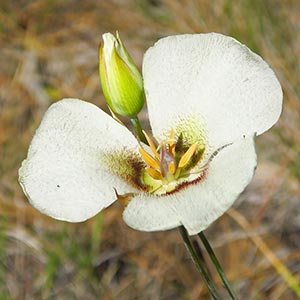Calochortus howellii
Calochortus invenustus
Howell's mariposa lily
plain mariposa, plain mariposa lily
slender, not branching or rarely branching in axil of cauline leaf, straight, 2–4 dm.
slender, usually not branching or twisted, 2–5 dm.
basal persistent, 20–35 cm;
blade gradually tapering distally, adaxially pubescent.
basal withering, 1–2 dm;
blade linear.
subumbellate, 1–3-flowered;
bracts 2, subopposite, linear to narrowly lanceolate, attenuate, 1–3 cm.
subumbellate, 1–5-flowered;
bracts 2–5 cm.
erect;
perianth open, campanulate;
sepals shorter than petals, ovate-acuminate, glabrous;
petals yellowish white, with purplish hairs toward base, broadly obovate, cuneate, inconspicuously fringed laterally, sparingly short-hairy adaxially, apex rounded;
glands transversely oblong, slightly depressed, densely covered with short, distally branching hairs, the bases of which unite at lower margin to form inconspicuous, discontinuous membranes;
filaments shorter than anthers;
anthers oblong-lanceolate, apex acute to short-apiculate.
erect;
perianth open, campanulate;
sepals lanceolate-ovate, 2–3 cm, apex acuminate;
petals white or dull lavender to purplish, with longitudinal median green stripe on adaxial surface and sometimes purplish blotch proximal to gland, cuneate to obovate, 2–4 cm, with a few short hairs near gland, apex obtuse to apiculate;
glands ± round, slightly depressed, small, surrounded by conspicuously fringed membrane, densely covered with short, distally branching hairs;
filaments 6–7 mm;
anthers purplish or yellowish, oblong, 7–8 mm, apex obtuse.
erect, 3-winged, ellipsoid, ca. 2 cm, base and apex acute.
erect, lanceoloid-linear, angled, 5–7 cm, apex acute.
light-colored, irregular.
flat.
= 20.
= 14.
Calochortus howellii
Calochortus invenustus
Calochortus howellii is known only from the Illinois River valley, Josephine County.
(Discussion copyrighted by Flora of North America; reprinted with permission.)


